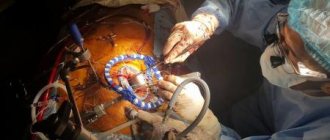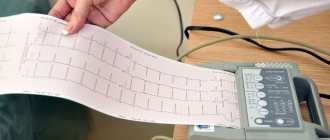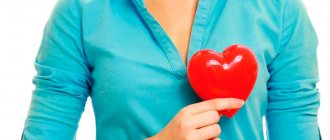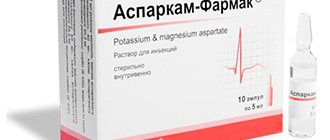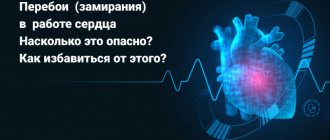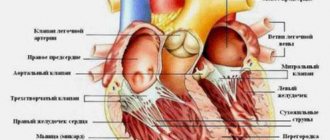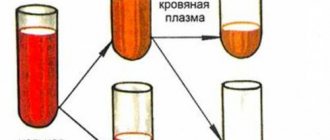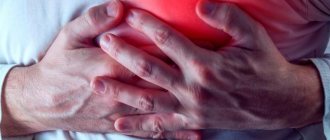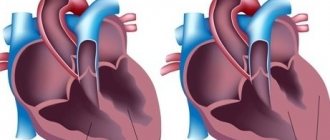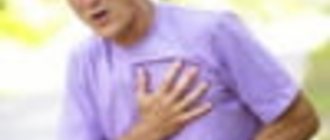Causes of heart failure
Physiological factors
Short-term discomfort in the precordial area is possible with severe fear, which is an absolutely normal situation. After eliminating the provoking factor, the unpleasant sensations disappear without a trace. Single extraordinary cardiac contractions, which are clinically manifested by freezing, are observed in 5-15% of absolutely healthy people. Their onset is provoked by nervous or physical stress, or a sudden change in weather.
Extrasystole
This type of arrhythmia most often causes the heart to freeze. Patients describe the sensation as a momentary “cardiac arrest” or talk about missing one heartbeat. Depending on the type of extrasystole, the symptom can be one-time or repeated several times in a row. The most dangerous condition is when freezing is felt in the form of regular episodes that follow every 2-3 heart beats.
The symptom is accompanied by a sharp deterioration of the condition. Patients complain of sudden dizziness, weakness, and shortness of breath. Fading of the heart during extrasystoles is characterized by a feeling of anxiety and lack of air. The skin turns pale or red. Depending on the etiological factor, extrasystole of functional, organic and toxic origin is distinguished.
Heart blocks
Heart stopping is felt during atrioventricular blockade, when the conduction of excitation from the atria to the ventricles is disrupted. With 1 degree AV block, such symptoms are observed very rarely. Small pauses in heart contractions are characteristic of 2nd degree blockade. The most pronounced freezing of heart contractions is in stage 3 disease, when the atria and ventricles work in different rhythms.
The symptom is characterized by a combination of constant weakness, decreased performance and physical activity. Freezing is accompanied by severe dizziness and shortness of breath, sometimes the attacks end in fainting. Clinical signs do not depend on the nature, activity and time of day. AV blockades occur with congenital heart defects, organic myocardial lesions, and intoxication.
Bradycardia
Fading of the heart is a common manifestation of bradycardia. The symptom, unlike extrasystoles, is not isolated, but continues for several hours or days. If a person listens to his feelings, he notices that the heart begins to beat much less often. In this case, uniform, long pauses occur between beats, which are interpreted as freezing.
Bradycardia manifests itself in a number of cardiac diseases: coronary heart disease, myocarditis and pericarditis, congenital and acquired defects. A short-term slowdown in rhythm is observed with a reflex effect - a blow to the neck or chest, being in very cold water, squeezing the neck with a tie or tight collar. Bradycardia occurs with hypothyroidism, fulminant hepatitis, and hyperkalemia.
Vegetative-vascular dystonia
With VSD, the symptom develops due to disturbances in the nervous regulation of the cardiovascular system. Freezing is more often observed during excitement, fear, and stress. Vegetative-vascular dystonia is characterized by short-term interruptions in heart function, which are then replaced by tachycardia. Symptoms are complemented by shortness of breath and weakness, dizziness, and increased sweating.
Depression
Complaints of a sinking heart are a typical symptom of a masked form of depression. Symptoms typically appear in the early morning hours. In addition to freezing, patients complain of nagging pain, discomfort, and an unreasonable feeling of fear - the so-called “precardiac melancholy.” During the day and evening, these manifestations are less intense or disappear altogether. With masked depression, other complaints are also disturbing: sleep disturbances, hypochondriacal and panic disorders.
Complications of pharmacotherapy
Many drugs used to treat cardiac patients can cause arrhythmias. Fading of the heart is often provoked by taking beta-blockers, cardiac glycosides, and diuretics. A slowdown in rhythm combined with unpleasant sensations in the heart are observed with incorrect dosage of calcium and potassium solutions, which is accompanied by the development of hyperkalemia.
What is extrasystole?
Listen, can you feel the rhythm of your heart?
Normally, you should not hear or feel its beating. If this does happen, then this is a reason to think about it and go to the doctor. Moreover, if you feel a slight blow to the chest, and then a pause, and this brings discomfort, then you are faced with an extrasystole. In scientific terms, extrasystole is a process during which a sudden additional contraction of the heart occurs due to an electrical impulse in one of its sections. Extrasystole is the most common type of arrhythmia.
According to statistics, extrasystole is recorded in 70% of healthy people. In more than 65% of cases, ventricular extrasystoles develop, 25% occur in the atrial ones and the rest - in
combined variants of extrasystole.
In its normal state, the heart contracts rhythmically, impulses are generated regularly, the sinus node and the electrical signal move according to the direction, down to the ventricles. But when the work of the heart is disrupted, a premature electrical jump occurs - an extrasystole. After it there is a pause, and then the heart begins to beat rhythmically again.
How does the heart's electrical system work? The sinus node is the main conductor of rhythm; its electrical signal is distributed throughout the atria, lingers slightly in the articular node and spreads throughout the ventricle.
During extrasystole, the sinus node temporarily stops functioning, because of this, the heart seems to turn off for a moment, literally freezing. Then an electrical surge appears in the ventricle and a contraction occurs, the heart begins to beat again, and the rhythm is restored.
What is premature contraction? This is a heart condition in which the heart beats earlier than it should. When the heart functions normally, the organ fills with blood. And when an extrasystole occurs, its work is suspended for a split second.
Diagnostics
Even if cardiac arrest is a rare episode, it is a reason to consult a cardiologist. Percussion can determine the expansion of the borders of the heart. During auscultation, muffled heart sounds and the presence of functional or organic noises are heard. To find out the cause of the symptoms, the doctor needs to obtain data from instrumental and laboratory research methods. Typically used:
- ECG.
During blockades, the ECG reveals a prolongation of the PQ interval and periodic loss of the QRS complex. Extrasystole is manifested by an extraordinary ventricular complex, after which a complete or incomplete compensatory pause occurs. Additionally, 24-hour Holter monitoring is prescribed. - EchoCG.
Ultrasound examination is necessary to find organic cardiac pathology that could cause freezing. Sonography can detect thickening of the heart wall, anatomical abnormalities, and a decrease in ejection fraction. Dopplerography is indicated to assess blood flow in the great vessels. - Biochemical tests.
Given the high prevalence of coronary artery disease, it is necessary to examine the blood lipid profile. The content of cholesterol and atherogenic LDL often increases. To exclude rheumatism and myocarditis, acute-phase blood parameters are determined - CRP, sialic acids. - Myocardial markers.
If cardiac arrest is accompanied by a serious condition of the patient and a sharp increase in symptoms, it is necessary to exclude a heart attack. For this purpose, the blood is examined for the level of troponin, myoglobin, AST and CPK enzymes. A slight increase indicates unstable angina, higher concentrations indicate myocardial necrosis. - Additional research.
If organic pathology is suspected, an MRI of the heart is performed. To identify signs of left ventricular heart failure, chest radiography is used. When cardiac arrest progresses to acute coronary syndrome, coronary angiography is performed.
Symptoms requiring medical attention
The manifestations are varied, as are the possible pathologies. An approximate systematization looks like this:
- Chest pain. A classic manifestation of any process. Does not always have a cardiac origin. Nonspecific and not typical for any one disease.
- Dyspnea. Usually due to heart defects. At first the minimum is invisible. Then it gets worse, leading to the inability to play sports and perform daily activities. The terminal phases of dangerous conditions end with the patient being unable to get out of bed and breathing problems begin.
- Heaviness in the chest. It is of an inexplicable nature, but it is not pain, but a different sensation. People cannot always explain it in understandable words. More often they just say discomfort.
- Non-productive cough (dry). In the later stages of the pathological process with a small amount of blood, without sputum in any case. Differential diagnosis of lung cancer or tuberculosis is also required. As a rule, the issue is resolved quickly, using an x-ray, as well as during the collection of anamnesis and assessment of health complaints.
- Weakness, drowsiness, decreased performance. Speaks of impaired blood circulation in the brain.
- Cephalgia. Usually of low intensity, but very obsessive and regular. May be falsely diagnosed as migraine. The issue is resolved under the supervision of a cardiologist, as needed by other specialists.
- Vertigo. Or dizziness. Due to cerebellar dystrophy, gradual disruption of tissue nutrition of cerebral structures. Up to a complete lack of orientation in space. Patients cannot walk or stand. This is already grounds for hospitalization.
- Weakness of cardiac activity. Actually a typical sign of arrhythmic pathologies. Feels like missing a beat.
- The heart freezes, then a strong beat is a classic sign of the onset of tachycardia paroxysm. What kind of acceleration of contractions this is - ventricular or atrial - needs to be clarified. The first variety is many times more dangerous.
- Impaired cognitive abilities, especially memory. It appears only with long-term hemodynamic abnormalities.
These signs require immediate medical attention.
You should not postpone it if you do not want to face fatal complications, such as arrest, heart attack, stroke, cardiogenic shock and other “delights” of advanced arrhythmia. Symptoms of cardiac arrest are variable and arise from the nervous system or muscle organ.
Treatment
Help before diagnosis
When heart palpitations occur, a person needs to immediately sit down and take a comfortable position. In case of rare heart contractions, it is better to lie on your back with your legs slightly elevated. It is necessary to provide access to fresh air by opening windows or doors. Usually the state of health returns to normal within a few minutes. If the patient feels worse, complains of pain in the precardiac region or fainting, emergency medical attention is required.
Conservative therapy
Effective treatment can begin only after the causes of cardiac arrest have been established. Patients with severe illness receive intensive parenteral therapy in the hospital or intensive care unit, but in most cases outpatient treatment is sufficient. To eliminate the root cause of the symptom, normalize heart function and regulate the heart rate, the following is prescribed:
- Antiarrhythmic drugs.
In the arsenal of cardiologists there are 4 classes of drugs that are indicated for arrhythmias. They start with monotherapy, but if high doses of drugs are ineffective or intolerable, the optimal result is shown by a combination of 2-3 drugs. - Beta adrenergic agonists.
The drugs improve conductivity and increase heart rate in patients with atrioventricular block. Medicines are used in short courses. If therapy is ineffective, pacemaker installation is considered. - Anti-inflammatory drugs.
For myocarditis and rheumatic diseases, NSAIDs are recommended, which reduce inflammatory damage to the myocardium. In severe systemic processes, it is advisable to treat with glucocorticoids. - Metabolic agents.
Antihypoxants and antioxidants are widely used, which improve myocardial function in conditions of insufficient blood supply and prevent free radical oxidation. To increase the contractility of the heart muscle, ATP drugs are administered.
What symptoms are associated with this sensation?
In medicine, there are more than 200 types of various rhythm disturbances, which most often occur in combinations in patients. A feature of arrhythmias is considered to be specific differences in the electrocardiogram and completely nonspecific clinical signs.
When patients talk about heart palpitations, most often they are talking about:
- non-rhythmic contraction of the myocardium of the ventricles and atria, which is felt as two independent rhythms;
- the presence of frequent extraordinary contractions, after which a compensatory pause occurs;
- incorrect rhythm (different intervals between contractions).
From an objective point of view, freezing can be called a pause in the heart rhythm lasting up to 2 seconds, after which tachycardia develops (rapid heartbeat).
